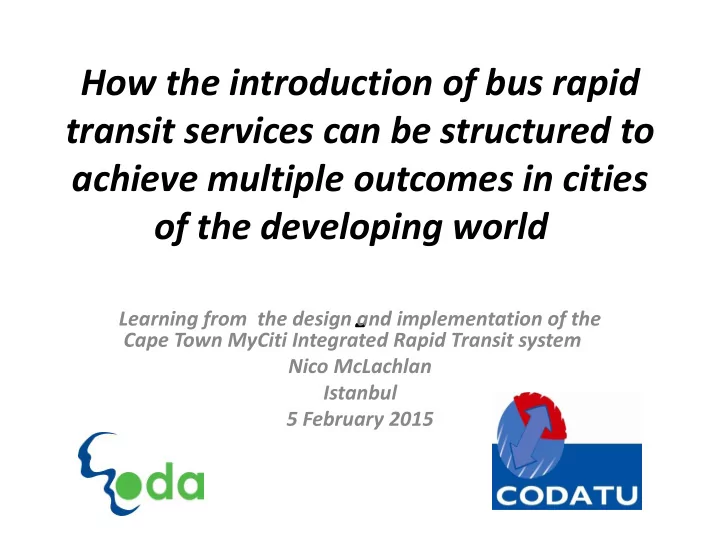

How the introduction of bus rapid transit services can be structured to achieve multiple outcomes in cities of the developing world - Learning from the design and implementation of the Cape Town MyCiti Integrated Rapid Transit system Nico McLachlan Istanbul 5 February 2015
Purpose of this discussion 1. To reflect on the range of developmental challenges usually experienced by cities of the developing world 2. To explore how urban mobility improvements can be structured to achieve multiple outcomes 3. To reflect on lessons from the Cape Town Myciti IRT system
Cities of the developing world Common developmental challenges 1. Rate and unplanned nature of urbanization 2. Urban form and related urban inefficiencies 3. Lack of reliable & safe scheduled public transport 4. Congestion , travel times , air and noise pollution 5. High accident rates and road safety related deaths and serious injuries
Outcomes that can/ should be achieved as a result of mobility improvements 1. Safe and reliable scheduled public transport services 2. Para-transit sector reform and economic empowerment 3. Sustained reduction of air and noise pollution 4. Promotion of NMT and integration of modes 5. Land value capture and transit oriented development
Cape Town’s Myciti phase 1 Targeting multiple outcomes 1. 31. 6 km of dedicated bus lanes constructed 2. 30 km of dedicated NMT lanes constructed 3. 800 minibus taxis removed from the area of operation and replaced by a fleet of 8 (18m), 68 (12m) and 222 (9 m) buses (298 buses in total) 4. The total MyCiti fleet is fitted with Euro IV compliant engines 5. All buses and stations comply with universal access standards 6. MyCiti provides an 18 hour a day , 365 days a year highly legible scheduled service using AFC
Cape Town Integrated Rapid Transit System West Coast Corridor
NMT lane next to BRT lane protected with natural vegetation
From 800 minibus taxis to 298 Euro IV compliant buses
12 & 18 m buses now in use
The standard 12 m high floor bus with universal access right side boarding and alighting
The 9m low floor feeder bus with right an left side universal access
Left side (pavement) universal access on feeder bus
Universal access at trunk station entry gates
Tactile paving internal to trunk station
Feeder bus stop Integration with University Student Shuttle service
Significant improvement to traffic signaling
Dead public spaces (under highways) converted into productive space
Productive use of dead space
Skateboarding park next to new MyCiti station under highway
Improved neighbourhood walkways & Cycle lanes
Integration of modes starts at airport MyCiti Airport Station
Integration of rail with MyCity Trunk bus at Woodstock station
The real success story: Para transit sector reform 1. 800 minibus taxi operators are now shareholders in three Bus Operating Companies. 2. These companies have negotiated 12 year operating contracts 3. The companies were capitalized with compensation paid to the minibus operators for cancelling operating licenses and surrendering vehicles 4. All affected minibus taxi drivers were trained to become bus drivers 5. Many ancillary paratransit sector workers are now formally employed at depots in various parts of the bus operation
Recommend
More recommend